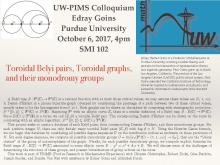A Belyĭ map \(β: \mathbb P^1(\mathbb C) \to \mathbb P^1(\mathbb C)\) is a rational function with at most three critical values; we may assume these values are \(\{ 0, \, 1, \, \infty \}\). A Dessin d'Enfant is a planar bipartite graph obtained by considering the preimage of a path between two of these critical values, usually taken to be the line segment from 0 to 1. Such graphs can be drawn on the sphere by composing with stereographic projection: \(β^{-1} \bigl( [0,1] \bigr) \subseteq \mathbb P^1(\mathbb C) \simeq S^2(\mathbb R)\). Replacing \(\mathbb P^1\) with an elliptic curve \(E\), there is a similar definition of a Belyĭ map \(β: E(\mathbb C) \to \mathbb P^1(\mathbb C)\). Since \(E(\mathbb C) \simeq \mathbb T^2(\mathbb R)\) is a torus, we call \((E, β)\) a toroidal Belyĭ pair. The corresponding Dessin d'Enfant can be drawn on the torus by composing with an elliptic logarithm: \(β^{-1} \bigl( [0,1] \bigr) \subseteq E(\mathbb C) \simeq \mathbb T^2(\mathbb R)\).
This project seeks to create a database of such Belyĭ pairs, their corresponding Dessins d'Enfant, and their monodromy groups. For each positive integer \(N\), there are only finitely many toroidal Belyĭ pairs \((E, β)\) with \(deg \, \beta = N\). Using the Hurwitz Genus formula, we can begin this database by considering all possible degree sequences \(\mathcal D\) on the ramification indices as multisets on three partitions of \(N\). For each degree sequence, we compute all possible monodromy groups \(G = \text{im} \, \bigl[ \pi_1 \bigl( \mathbb P^1(\mathbb C) - \{ 0, \, 1, \, \infty \} \bigr) \to S_N \bigr]\); they are the "Galois closure" of the group of automorphisms of the graph. Finally, for each possible monodromy group, we compute explicit formulas for Belyĭ maps \(β: E(\mathbb C) \to \mathbb P^1(\mathbb C)\) associated to some elliptic curve \(E: \ y^2 = x^3 + A \, x + B\). We will discuss some of the challenges of determining the structure of these groups, and present visualizations of group actions on the torus.
This work is part of PRiME (Purdue Research in Mathematics Experience) with Chineze Christopher, Robert Dicks, Gina Ferolito, Joseph Sauder, and Danika Van Niel with assistance by Edray Goins and Abhishek Parab.
Edray Herber Goins is a Professor of Mathematics at Purdue University, working number theory, as it pertains to the intersection of representation theory and algebraic geometry. Prof. Goins grew up in South Los Angeles, California. The product of the Los Angeles Unified (LAUSD) public school system, Prof. Goins attended the California Institute of Technology, where he majored in mathematics and physics, and earned his doctorate in mathematics from Stanford University.
